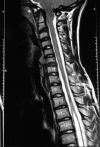Chiari Type I malformation yielded to the diagnosis of Crouzon syndrome
- PMID: 24741262
- PMCID: PMC3985371
- DOI: 10.4103/0976-3147.127885
Chiari Type I malformation yielded to the diagnosis of Crouzon syndrome
Abstract
Chiari malformation Type I (CM-I) related to syndromic craniosynostosis in pediatric patients has been well-studied. The surgical management consists of cranial vault remodeling with or without posterior fossa decompression. There were also cases, in whom CM-I was diagnosed prior to the craniosynostosis in early childhood. We present a 16-year-old boy who admitted with symptoms related to CM-I. With careful examination and further genetic investigations, a diagnosis of Crouzon syndrome was made, of which the patient and his family was unaware before. The patient underwent surgery for posterior fossa decompression and followed-up for Crouzon's syndrome. To our knowledge, this is the only case report indicating a late adolescent diagnosis of Crouzon syndrome through clinical symptoms of an associated CM-I.
Keywords: Chiari malformation Type I; Crouzon syndrome; craniosynostosis; posterior fossa decompression.
Conflict of interest statement
Figures




References
-
- Crouzon LE. Dysostose cranio-faciale hereditaire (Hereditary cranio-facial dysostose) Bulletin de la Societe des Medecins des Hopitaux Paris. 1912;33:545–55.
-
- Gray TL, Casey T, Selva D, Anderson PJ, David DJ. Ophthalmic seqeulae of Crouzon syndrome. Ophthalmology. 2005;112:1129–34. - PubMed
-
- Fujisawa H, Hasegawa M, Kida S, Yamashita J. A novel fibroblast growth factor receptor 2 mutation in Crouzon syndrome associated with Chiari Type I malformation and syringomyelia. J Neurosurg. 2002;97:396–400. - PubMed
-
- Leikola J, Koljonen V, Valanne L, Hukki J. The incidence of Chiari malformation in nonsyndromic, single suture craniosynostosis. Childs Nerve Syst. 2010;26:771–4. - PubMed
Publication types
LinkOut - more resources
Full Text Sources
Other Literature Sources
